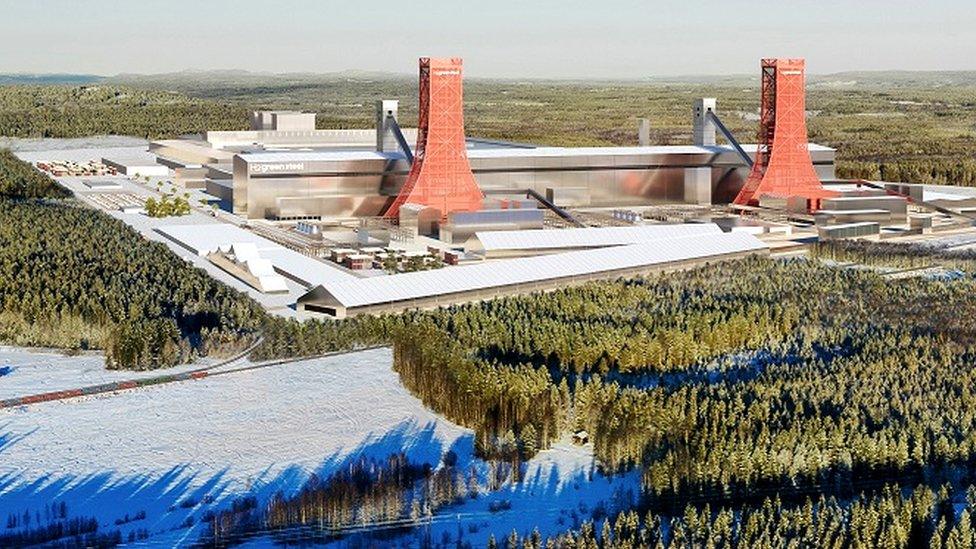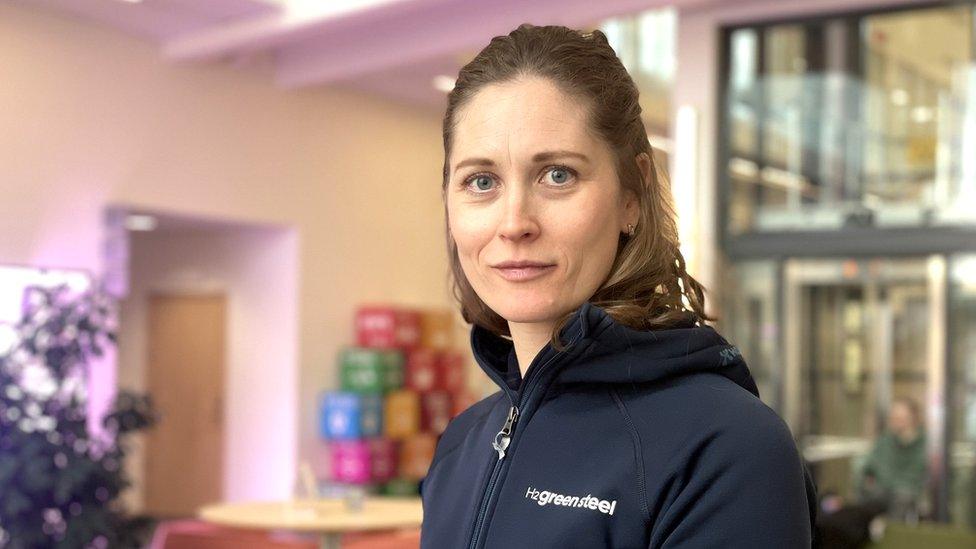The race across Europe to build green steel plants
- Published

Construction of a green steel plant is underway in northern Sweden
A small military town in Sweden's frozen north is on course to produce Europe's first commercial green steel.
Giant diggers and excavators are powering through layers of mud, ice and snow at the site of a new steel plant just outside Boden, 900 km (559 miles) north of Stockholm.
At 09:00, the sun has only just risen and the temperature is -8C. Some of the workers are wearing three or four jackets, and have switched on the heated seats in their vehicles.
Steel is usually made in a process that starts with blast furnaces. Fed with coking coal and iron ore, they emit large quantities of carbon dioxide and contribute to global warming.
The production of steel is responsible for around 7% of the world's greenhouse gas emissions. But in Boden, the new plant will use hydrogen technology, designed to cut emissions by as much as 95%.
Although the first buildings have yet to go up on the remote site, the company behind the project, H2 Green Steel, believes it's on course to roll out the first commercial batches of its steel by 2025.

The new plant should be producing green steel by 2025
If it succeeds, it will be the first large-scale green steel plant in Europe, with its products used in the same way as traditional steel, to construct everything from cars and cargo ships to buildings and bridges.
Although much of Europe's steelmaking industry dates back centuries, H2 Green Steel is a start-up that didn't even exist before the pandemic.
When Northvolt opened Sweden's first giant electric battery factory two hours south of Boden, it wanted to find a greener way of producing the steel needed to make the batteries, and H2 Green Steel emerged as a spin-off with funding from two of Northvolt's founders.
Audio: The remote Swedish town leading in green steel
The centrepiece of the new steel plant will be a tall structure called a DRI tower (DRI means a direct reduction of iron). Inside this, hydrogen will react with iron ore to create a type of iron that can be used to make steel. Unlike coking coal, which results in carbon emissions, the by-product of the reaction in the DRI tower is water vapour.
All the hydrogen used at the new green steel plant will be made by H2Green Steel.
Water from a nearby river is passed through an electrolyser - a process which splits off the hydrogen from water molecules.
The electricity used to make the hydrogen and power the plant comes from local fossil-free energy sources, including hydropower from the nearby Lule river, as well as wind parks in the region.

Boden is a 'unique' spot for green steel production says Ida-Linn Näzelius
"This a unique spot to start with. You have to have the space, and you have to have the green electricity," says Ida-Linn Näzelius, vice president of environment and society at H2 Green Steel.
H2Green Steel has already signed a deal with Spanish energy company Iberdrola to build a green steel plant powered by solar energy in the Iberian peninsula, and says it's exploring other opportunities in Brazil.
On home soil it's got friendly competition from another Swedish steel company, Hybrit, which is planning to open a similar fossil-free steel plant in northern Sweden by 2026. This firm is a joint venture for Nordic steel company SSAB, mining firm LKAB and energy company Vattenfall, boosted by state funding from the Swedish Energy Agency and the EU's Innovation fund.
While Sweden is leading the way when it comes to carbon-cutting steel production in Europe, it is important to put its potential impact in context, says Katinka Lund Waagsaether, a senior policy advisor at the Brussels-based climate think tank E3G.
H2 Green Steel hopes to produce five million tonnes of green steel a year by 2030. Global annual production is currently around 2,000 million tonnes, according to figures from the World Steel Association, external.
"The production capacity in Sweden will be a drop in the sea," says Ms Lund Waagsaether.

A key part of the steel prodution process happens in the DRI tower where hydrogen reacts with iron ore
But other ventures should help increase the proportion of green steel available in Europe.
These include, GravitHy, which plans to open a hydrogen-based plant in France, in 2027. German steel giant Thyssenkrupp recently announced it aims to introduce carbon-neutral production at all its plants by 2045. Europe's largest steelmaker ArcelorMittal and the Spanish government are also investing in green steel projects in northern Spain.
Meanwhile, the EU is in the process of finalising a new strategy called the Carbon Border Adjustment Mechanism, designed to make it more expensive for European companies to import cheaper, non-green steel from other parts of the world.
"I think it is important in that it'll give industry the confidence to invest, because they can see that, at least in the European context, their steel will be competitive," says Ms Lund Waagsaether.


She also points to a "a crucial window of action" between now and 2030, with around 70% of steelworks around the world in need of repair and reinvestment during this period.
Blast furnaces could be replaced or relined to extend their lifetimes, but a smarter long-term strategy, argues Ms Lund Waagsaether, would be to invest in switching to carbon-cutting production processes instead.
"The next eight years are crucial for making sure that companies and investors globally make decisions towards green steel production... which is going to 'lock us in' for another few decades."
But whether the majority of big steel producers will follow this path is difficult to predict, says Lundberg. "I would say I'm hopeful, but we need to keep the pressure up."

The switch to green steel will have to factor in jobs says Chris McDonald
In the UK, the government is reported to be ready to stump up £600m to help Britain's two largest steelmakers switch away from coal-fired blast furnaces. However the country remains "very much a laggard" in green steel circles, according to Chris McDonald, chief executive of the UK's national innovation centre for steel and metals, the Materials Processing Institute.
"A big reason for that is that currently the UK has very high energy prices compared with other countries, and that means it makes the steel industry unsustainable and it makes investment less attractive in the UK."
Another challenge, says Mr McDonald, is figuring out how to negate high unemployment in industrial heartlands if existing steel plants shut down, or require different skill sets from employees once they've been remodelled. "It's more complicated, I think, than just opening up the market and allowing new entrants to come in, because we're trying to manage a green transition and to manage the social consequences at the same time," he argues.
In Boden, the arrival of H2 Green Steel is being viewed as a major opportunity for job creation in an area that's been crying out for new industries for decades.
The small military town shrunk after army budget cuts and closure of a large hospital in the region in the 1990s, resulting in thousands of people moving elsewhere to find work.
"This is our biggest opportunity in more than 100 years," says the town's Social Democrat mayor Claes Nordmark. "This will mean jobs, it will mean more restaurants, it will bring more sponsorship to our football and ice hockey and handball team and so on… it means everything for us."